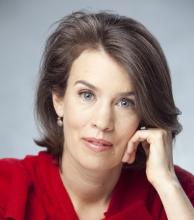About the Author: Kate Hosford '88
 |
| Visit Kate's website |
Current Home
Brooklyn, New York
Place of Birth
Farmington, Maine
Education
Harwood Union High School, Moretown, Vermont (1984)
Amherst College (1988)
Pratt Institute (2000)
Vermont College of Fine Arts (2011)
Why did you choose to come to Amherst?
The relatives on my father’s side of the family were all from Amherst and the surrounding towns. My father, grandfather and other relatives had all gone to Amherst, so my interest in the college was a natural outgrowth of spending so much time around the college as a child. Amherst might have seemed small and intimate to many people, but after growing up in Vermont, I found it large and exciting.
What was your favorite class?
My Russian literature classes with Professor Rabinowitz. In addition to learning a lot about Russian literature, I loved Professor Rabinowitz’ charisma, his photographic memory, and his formidable acting skills. He would skulk around the classroom impersonating various tortured literary characters. It was fabulous.
Favorite Professors:
Stanley Rabinowitz, William Pritchard, William Kennick
Favorite Book:
Because I am a children’s author, I am going to name my favorite children’s book: The Giver by Lois Lowry.
Favorite Author:
If I must choose only one children’s author, then it will be Shel Silverstein.
Awards and Prizes:
1989: Rotary Scholarship to study in Göttingen, Germany.
2011: Big Bouffant shortlisted for the Mockingbird Award
Tips for Aspiring Authors:
I think writers have to be sensitive enough to write authentically, but tough enough to withstand the years of rejections before being published, and the continued roadblocks they will encounter after publication. It is also necessary to make sure that you simply show up to work in order to stay inspired. I like this quotation from A Poetry Handbook by Mary Oliver about courting one’s muse. She refers to the process of making a poem here, but it could apply to any creative endeavor:
The part of the psyche that works in concert with consciousness and supplies a necessary part of the poem—the heat of a star as opposed to the shape of a star, let us say—exists in a mysterious, unmapped zone: not unconscious, not subconscious, but cautious. It learns quickly what sort of courtship it is going to be. Say you promise to be at your desk in evenings, from seven to nine. It waits, it watches. If you are reliably there, it begins to show itself—soon it begins to arrive when you do. But if you are only there sometimes, or are frequently late or inattentive, it will appear fleetingly, or it will not appear at all.
In addition to writing, it’s crucial to carve out a lot of time to read. I know that seems obvious, but I think it’s necessary for a writer to view reading as one of the most important parts of her job, even if it means writing ‘read’ in her daily schedule, so that the time doesn’t get eaten up by some other task.
Tell us a bit about your path to becoming an author:
I began to write at age thirty-five when my first son was born. I was working as an illustrator at the time, and hoped that I might get more illustration work if I promoted my self as an author and an illustrator. It soon became clear that writing came to me more naturally than illustrating. After a while, I was simply having more fun writing. I was able to let my imagination go wild and not feel bogged down by some of the technical issues that are important in illustration.
I didn’t sell any manuscripts initially, but I had enough good feedback from editors to keep me going for the next eight years, until I sold my first two books. Last year, I graduated from Vermont College of Fine Arts with a Masters in Writing for Children and Young Adults. This program provided invaluable training in the craft of writing and introduced me to an amazing network of writers.